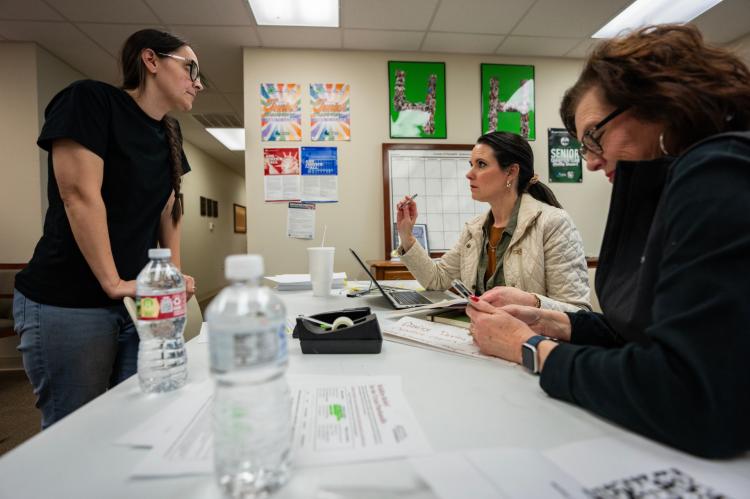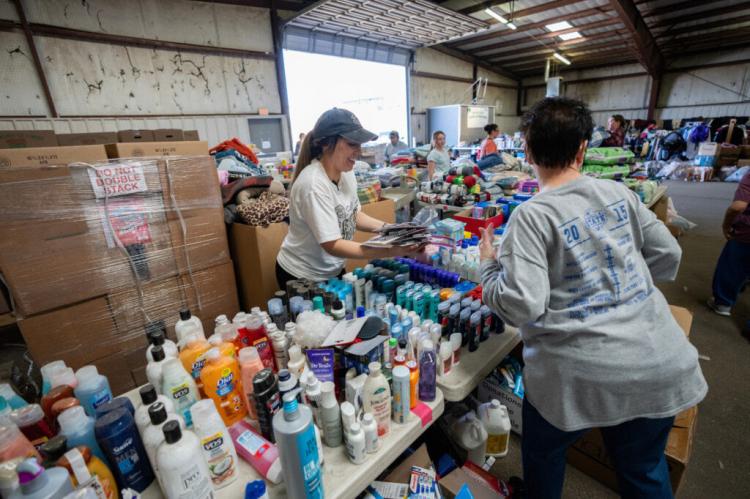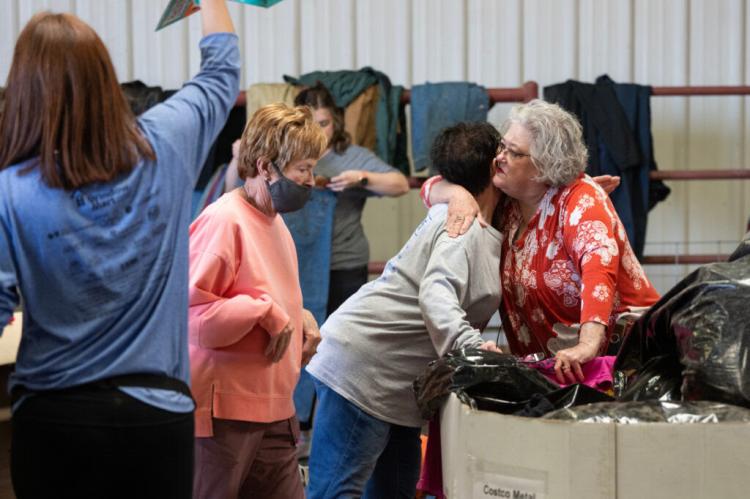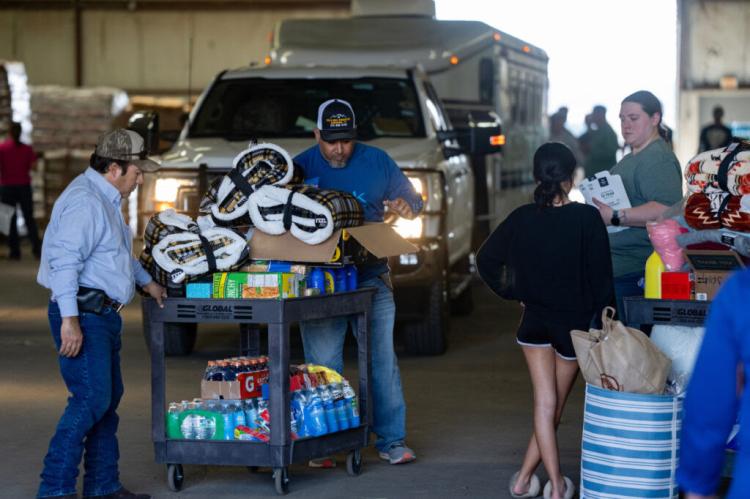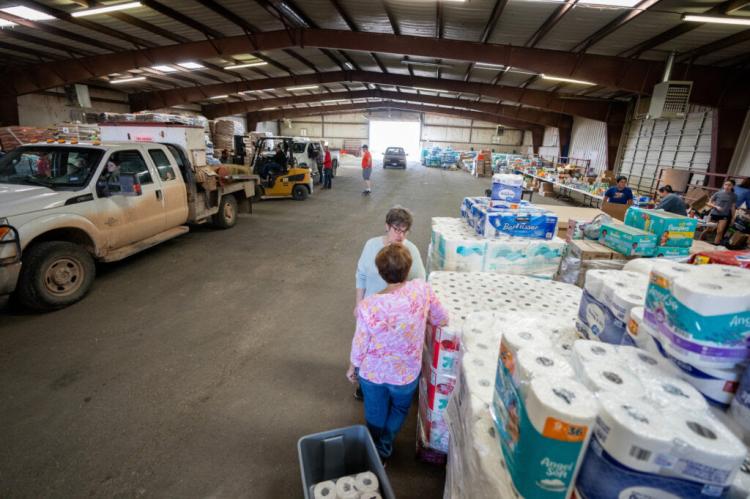Taking care of people in need
AgriLife Extension outreach manages outpouring of wildfire donations
Tanya Holloway, Texas A&M AgriLife Extension Service family and community health, FCH, agent in Hemphill County, wasn’t even in town when the Smokehouse Creek Fire started on Feb. 26. And with the fires raging, she couldn’t get all the way home to Canadian when she hurried back to the Texas Panhandle from a training in San Angelo.
But when she finally walked through the doors of the AgriLife Extension office on Feb. 28, she was prepared — by lessons learned over multiple disasters — to handle what has taken place during the past two weeks.
People throughout the state, nation respond
Toiletries, pots, pans, diapers, wipes, linens, water, food, water and more water began pouring into the AgriLife Extension supply point established primarily for human needs at the Hemphill County Exhibition Center.
Such an outpouring of kindness had to be managed to ensure effective outreach to those in need as well as to keep track of the 1,000s of donations coming in from across the nation.
In the 2017 fires, Hemphill County only had two homes burned, so helping those people affected through donated household items was not a major issue.
But when the fires hit again in 2022, some homes were burned to the ground, and one was uninsured. That’s when Holloway first put together a task force for the human side of wildfire recovery – including bringing together representatives from schools, hospitals, the city, the county, the chamber of commerce and local churches – every group that would play a role. They created a 501(3)c run through the First Baptist Church and the Ministerial Alliance.
“This year, we’ve had 58 homes burn to the ground or that are uninhabitable, and 19 were uninsured,” Holloway said. “When you have 58 homes damaged in a community this size, that has a large effect.”
The ‘helping hands’ of AgriLife Extension appear
Just mentioning what happened as she began to tackle the monumental tasks that awaited her brings Holloway to tears. They showed up – her AgriLife Extension “people.”
“My very first people who showed up were our 4-H moms,” she said. “I could look at them, and I knew who could handle what. I knew when I asked them, it would be handled and done right. Our AgriLife Extension community, both agriculture and FCH people, have just all shown up, and brought more help with them.”
Long before outside agencies arrived on the scene, she said, “We were off and running and identifying our families. We knew who had lost their homes, and we were working through Facebook to find out where they were living and who needed help.”
All totaled, she estimates about 40 people have been a part of the current human relief efforts – with many helping every day and some for a day or two. Some young men from Missouri showed up and worked the weekend; the local football team came out and spent the day unloading sacks; and numerous church groups pitched in to help.
The county exhibition center, which is primarily the intake point for the human side of the disaster, was also needed for inside storage for sacked feed – pet food and livestock feed, fencing supplies and square bales of hay. So, they had more than just home goods to manage.
The rest of the larger agriculture supplies are being stored at Canadian Animal Health and Nutrition, the local feed store, at 100 Hackberry, where Holloway’s husband Andy, an AgriLife Extension agriculture and natural resources agent, devotes much of his time.
Holloway said another group she depended on was three retired women who are food pantry volunteers and connected with her through their church. They did all the calling and outreach to identify anyone displaced by the fire and determine their needs. One is now helping the ag side identify who was affected and helping to get an accounting of losses, whether equipment, grassland, cattle or fencing.
“Sometimes, it just takes a while before people come in for help; maybe they haven’t used our services before,” Holloway said. “We need to know where we need to be helping so, to the best of our ability, we don’t miss anyone.”
Ensuring the donations go to those in need
“This is AgriLife Extension handling this donation site,” Holloway said, which means education is an important aspect of the recovery process. This includes letting people know to be wary of scams, helping them understand the necessary protocols associated with getting assistance and explaining how to maximize state funding for the good of the community.
“If you don’t take care of the paperwork with details, we don’t get that support,” Holloway said. “Everything must be documented, and we are trying to help with that process. There must be some accountability to ensure the donations reach the individuals in need.”
She said her continuous message to those who call wanting to make donations is: “I can assure you we have a committee that will assess the needs, and it will be distributed accordingly. Your money will go to the people – not the bureaucracy.”
The committee started a rubric based on the percentage of loss, she said. If someone lost a home and has no insurance, they might get more money, but, eventually, every single person or household will get something to help.
“We are at that point working our way through this process. We want to help them consider all their losses — contents, equity in the home, landscaping – things they may not consider at this time as they are trying to begin the recovery process,” Holloway said.
A resource fair on March 9, hosted by the Texas Department of Emergency Management and other agencies, helped work through many of those issues with the people who needed help.
Outpouring of love becomes responsibility
While most everyone is well-meaning and helpful in times of disaster, sometimes people don’t think about the gravity of all of it, Holloway said.
“We had a company that wanted to donate 500 boxes of chicken quarters. We had to let them know the people who might use them no longer had freezers, and the entire town didn’t have that much freezer space; some didn’t even have electricity,” she said.
“We must look at the people in need and see what is happening in their homes and lives to determine what they really need. There is nothing normal up and running for many of them. We must start with where they are and determine what they can use. For instance, where would they put five bags of clothes if they are now living in a fifth wheel?”
She said she tries to convey that it is easier to give people the means to buy their own clothes rather than sort through clothes that might need to be repaired, laundered and sorted. That is one reason Holloway did not ask for clothing donations, although many still showed up.
The donation outflow is much slower than the intake, so while Holloway and her volunteers are trying to send supplies out, the building is filled wall to wall. They are now at a maximum on home donations.
“Right now, many people don’t have a place to live and until they can sort through those things, it will take time before they can come pick up more of these supplies,” she said.
Holloway said she started learning the “process thinking” about 35 years ago when she was part of a women’s Christian outreach group. She said people love to send clothes and water, so stemming that tide early is important. She has circulated another message far and wide — no more water; they have enough to fill five swimming pools already.
Over the years, Holloway said she found that what works in a one-town county or rural area is very different from what works in an urban county. So, this wildfire and the response are much different than taking care of a disaster such as Hurricane Harvey in a much larger town. People in the cities need help putting things in perspective when they call to donate. They see the massiveness of the acreage, but they don’t understand it is not a large number of people.
“It’s a different mindset, and it can’t be pigeon-holed,” Holloway said. “I’m the agent here, so my goal is to take care of my people to the best of my ability. We are both state and county employees, and I will do what I can for them. And that’s how the people on the task force feel. These are our people, our families and our friends. We want to be there for them.”
Disaster brings back all too familiar feelings, thus understanding
Holloway said she and her husband have a special dedication to helping others pull through the disaster because they understand what it is like to lose everything.
“Ours wasn’t the same way, but drought took our livelihood away, so while this isn’t a drought, we know how they feel having to start over,” she said. “We are tied to these people – they saved us, loved on us and took care of us. Now, we need to be there for them.”
Some people lost their homes and cattle, some just lost cattle and some just lost their homes, but there is no one in the town who is not affected by the whole disaster, Holloway said. The ranches pay taxes and that affects the school, hospital, bank and all the stores in town.
“Either people need our help, or they are here to help,” she said.
Holloway is now using the Reach app to maintain contact with all the people who lost their homes, updating them on items available to be picked up and asking them to let her know if there are specific items they need. She has been given Amazon cards to order items that will keep the families living day to day.
“My plan is to keep things here through the end of May,” she said. “We want to give people time to get back on their feet, and their needs while they are in some temporary housing will be different than when they move into more permanent housing.”
She said once the fencing starts in force, they will want to make sure the crews can come get water and snacks, such as the snack bags they fixed for the ranchers and their cowboys riding the pastures after the fire to assess damages.
Finally, Holloway said, “You always have to have an exit plan.” There must be a plan for what to do with things that are left over, especially if there is someone who could use them. She is currently looking for good uses for all the extra water they received.
“We can send it on the bus with our kids headed to sporting events or wherever,” she said. “Right now, just about anyone or any organization that needs water should be able to get it.”
(Click on the top image to see the slide show)

